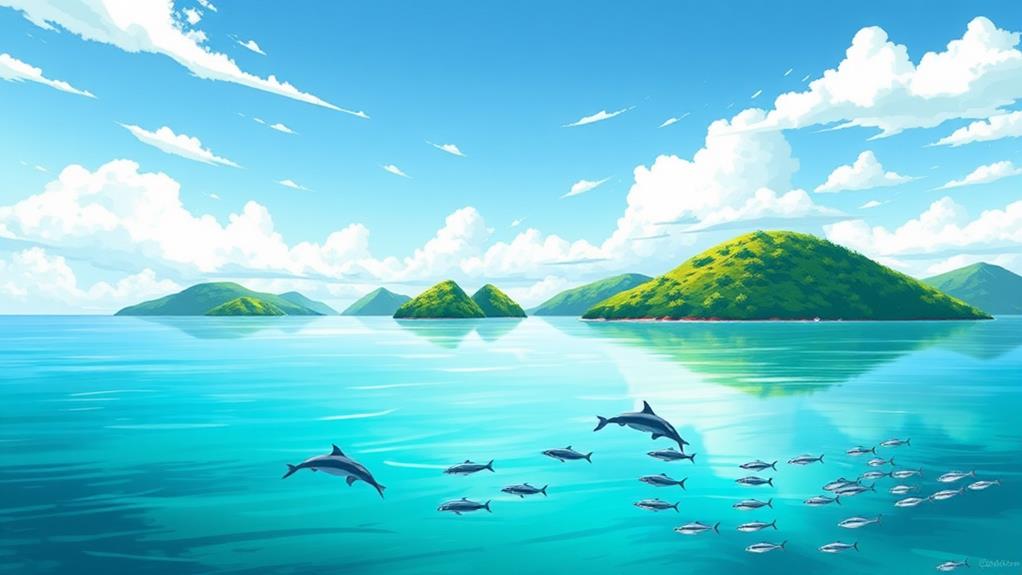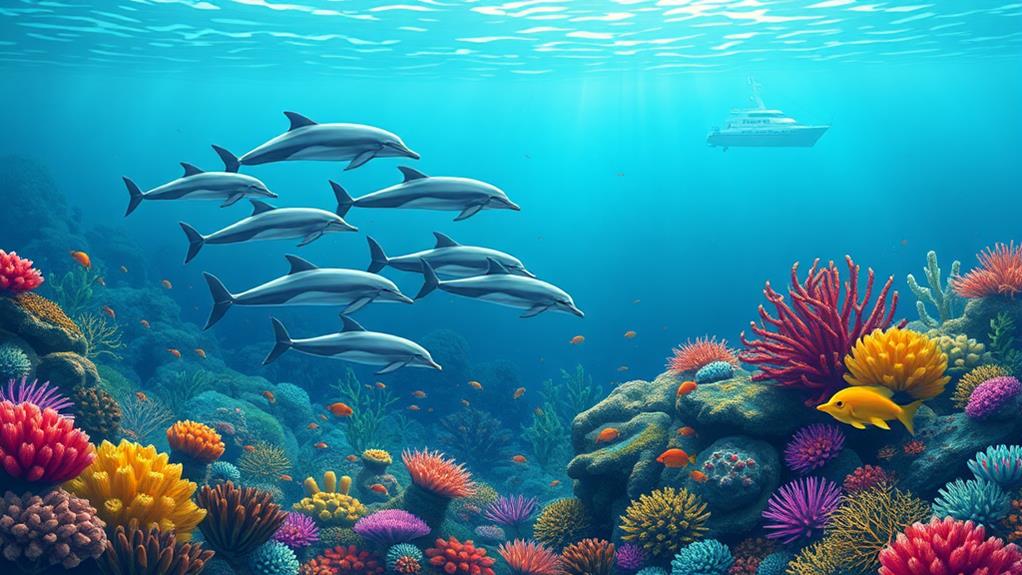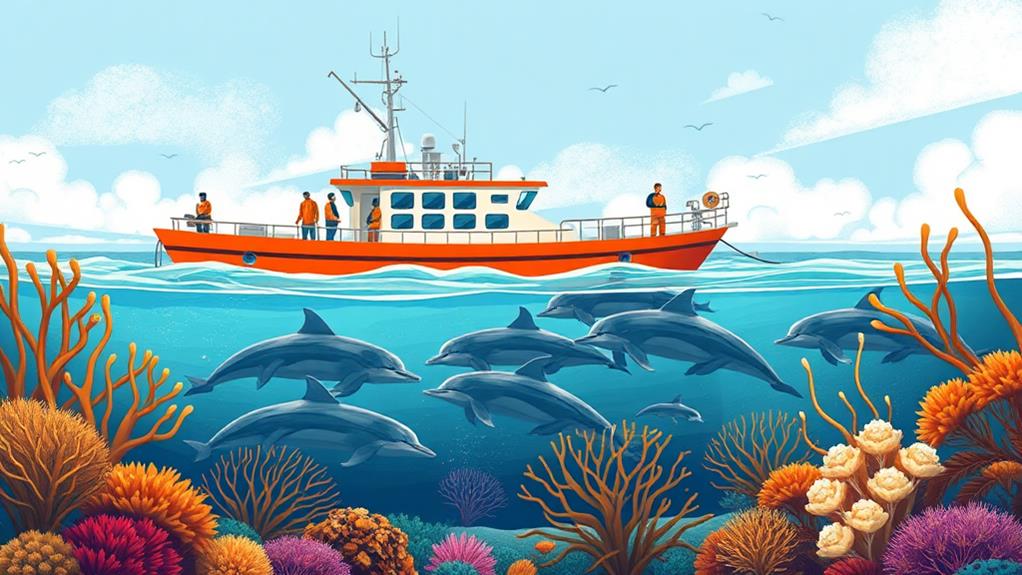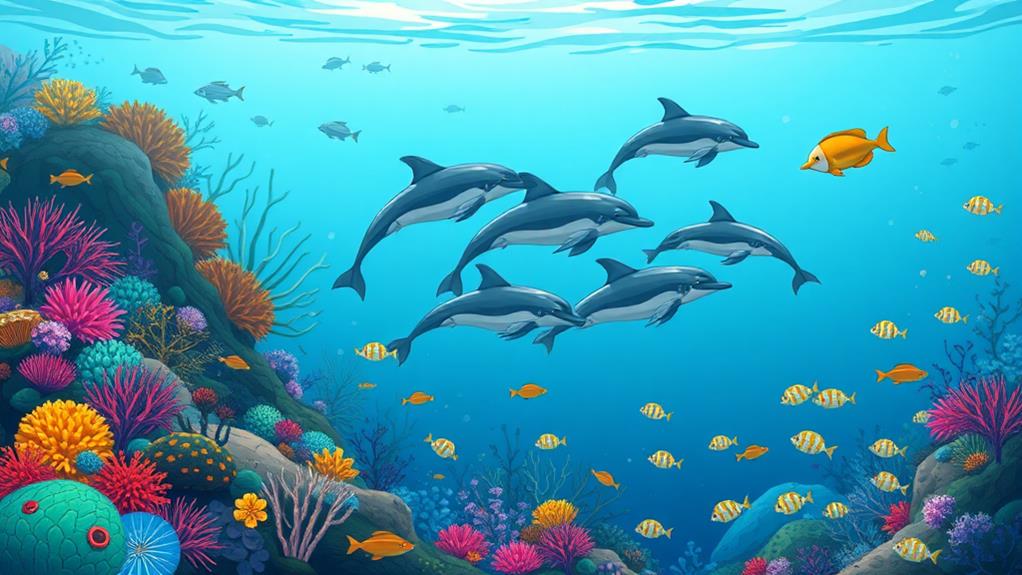The Taño Strait Protected Seascape is the largest protected area in the Philippines, spanning 161 km between Cebu and Negros islands.
This marine corridor is home to 62% of the country's coral species, making it a vital habitat for marine life.
Fourteen cetacean species, including spinner dolphins and dwarf sperm whales, inhabit this protected seascape, which was designated as such in 1998.
The primary focus of this designation is cetacean protection and sustainable resource management.
Overview of Tañon Strait

Tañon Strait: A Vital Marine Corridor
Tañon Strait, stretching 161 kilometers between Cebu and Negros islands in the Central Philippines, forms a crucial marine passage.
This Strait is the largest protected area in the country.
Rich Marine Biodiversity
The Strait is home to a diverse range of marine life.
62% of the Philippines' coral species can be found here. It also provides a habitat for 14 species of whales and dolphins, including the common spinner dolphin and the dwarf sperm whale.
Conservation Efforts
Designated as the Tañon Strait Protected Seascape in 1998, the area aims to fully protect cetaceans and support sustainable marine resource management.
The diverse ecosystems within the Strait, including mangrove forests, intertidal zones, and coral reefs, are critical for juvenile fish and crustaceans, ultimately supporting local fisheries and livelihoods.
Importance of Preservation
Preserving the unique ecosystem of Tañon Strait is essential for maintaining the health of our oceans and the communities that depend on them.
Environmental Challenges Ahead
The Tañón Strait is facing significant environmental challenges that threaten its delicate balance.
The presence of high-density microplastics in certain areas of the Strait poses significant risks to marine life and biodiversity. For example, microplastics have been found in the digestive systems of fish and other marine animals, causing harm and even death.
Local residents' limited awareness of environmental issues contributes to the ongoing degradation of marine ecosystems. Many local residents aren't aware of the impact of their daily activities, such as littering and improper waste disposal, on the marine environment. As a result, these activities continue to harm the Strait's ecosystem.
The growing popularity of dolphin and whale watching activities has been linked to stress and evasive behaviors among marine mammals. The noise and disturbance caused by these activities can disrupt the natural behavior of marine mammals, leading to stress and changes in their behavior.
Human activities, including overfishing and pollution, continue to threaten the ecological balance and health of the Tañón Strait's marine environment. Overfishing depletes fish populations, while pollution from agricultural runoff, industrial activities, and other human activities harms marine life and habitats. These activities are interconnected, and addressing one challenge often requires tackling multiple issues simultaneously.
Urgent conservation and sustainable management efforts are required to protect the rich biodiversity of the Tañón Strait. To protect the Strait's ecosystem, it's essential to implement measures such as reducing plastic waste, promoting sustainable fishing practices, and increasing awareness about environmental issues among local residents and tourists.
Conservation Mission and Strategies

Conservation Mission and Strategies
The Tañon Strait's rich biodiversity is protected through a conservation mission that focuses on sustainable management of coastal and marine resources. This mission uses science-based approaches to inform decision-making, ensuring that management efforts are grounded in empirical evidence.
Participative Decision-Making and Co-Management
The conservation mission engages stakeholders through participative decision-making and co-management strategies, fostering a sense of ownership and responsibility among local communities, fishermen, and ecotourism operators. This collaboration is critical for preserving marine biodiversity.
Awareness Campaigns and Cooperation
Awareness campaigns and cooperation among stakeholders are essential for protecting marine resources.
Management zoning workshops promote harmonious interactions between human activities and ocean ecosystems within the Strait.
Ongoing Research and Monitoring
Ongoing research and monitoring initiatives assess population dynamics, particularly for marine mammals like dolphins.
These efforts allow conservation strategies to adapt to emerging threats. By supporting these initiatives, you can help safeguard the Strait's marine resources, ensuring the long-term sustainability of dolphin and whale watching, and other eco-tourism activities.
Upcoming Events and Activities
Upcoming Events in the Taño Strait Protected Seascape
World Seagrass Day
On March 1, 2024, the Taño Strait Protected Seascape will celebrate World Seagrass Day, highlighting the importance of seagrass ecosystems for marine biodiversity. This event aims to raise awareness about the crucial role seagrass plays in supporting marine life and the protected seascape's ecosystem.
Earth Month Celebrations
In April 2024, the Taño Strait Protected Seascape will dedicate the month to Earth Month Celebrations, focusing on environmental awareness and conservation efforts in the region. The celebrations will culminate on April 22, 2024, with Earth Day, promoting community engagement in protecting marine resources.
Month of the Ocean
May 2024 is designated as the Month of the Ocean, emphasizing the significance of ocean conservation and the diverse marine life in the Taño Strait, where dolphins thrive. This event aims to educate the public about the importance of ocean conservation and the unique biodiversity of the protected seascape.
International Coastal Clean Up Day
On September 21, 2024, the Taño Strait Protected Seascape will participate in the International Coastal Clean Up Day, joining local communities and volunteers in cleaning efforts to combat plastic pollution in the Strait. This event aims to engage the community in protecting the marine environment and promote a deeper appreciation for the protected seascape's unique biodiversity.
Management and Monitoring Initiatives

Effective Management Initiatives Protect Cetaceans
Fourteen cetacean species, including dolphins, rely on effective management and monitoring initiatives to thrive in the Taño Strait Protected Seascape. The Taño Strait Protected Seascape, located in the Philippines, is a critical area for marine biodiversity in the Verde Island Passage. Effective management and monitoring initiatives are essential to ensure the conservation of these cetacean species and the overall health of the marine ecosystem in the area. By implementing measures such as habitat protection, sustainable fishing practices, and pollution control, authorities can help to safeguard the rich marine biodiversity in the Verde Island Passage for future generations.
Coastal law enforcement plays a vital role in preserving marine biodiversity by enforcing fishing regulations, which helps protect various species, including the 14 cetacean species that call this seascape home.
Socio-Economic Assessments Inform Sustainable Fishing Policies
To ensure sustainable fishing practices, socio-economic assessments are conducted to understand the impact of local communities on marine resources.
These assessments inform policies that promote responsible fishing methods, reducing the strain on marine ecosystems.
Education and Biophysical Assessments Support Conservation Efforts
Communication and education campaigns are implemented to raise public awareness about the importance of marine conservation and the threats posed by human activities, fostering community involvement in protection efforts.
Biophysical assessments monitor the conditions of coastal resources, ensuring that management strategies are based on scientific data and ecological needs.
Management Zoning Workshops Promote Sustainable Resource Use
Management zoning workshops are organized to facilitate harmonious interactions between human activities and marine ecosystems,
promoting sustainable resource use in Taño Strait. By combining these initiatives, a healthier, more resilient marine environment is maintained.
Marine Mammal Species Found
The Taño Strait Protected Seascape is home to 14 cetacean species, with 9 species confirmed in recent surveys. The Indo-Pacific bottlenose dolphin (Tursiops aduncus) and spinner dolphin (Stenella longirostris) are among the most notable species, with the latter being the most common.
The estimated population of spinner dolphins in Taño Strait is around 3,500 individuals, indicating a high diversity among odontocetes in the region.
Other marine mammal species found in the Strait include Rissos dolphins and dwarf sperm whales, contributing to the area's ecological richness.
However, recent surveys have highlighted a concerning decline in dolphin populations, with evasive behavior observed among dolphins, suggesting stress induced by increased human activities.
Qualifying Criteria for Protection

The Tañon Strait meets multiple criteria for protection due to its unique characteristics and ecological significance as an essential habitat for marine mammals.
Criterion B is met because the Strait is home to a small resident population of bottlenose dolphins, with 121 catalogued individuals observed across 50 encounters from 2014-2015.
The Strait also meets Criterion C2 as it's identified as a productive foraging ground for spinner dolphins, with important feeding areas likely located in deeper mesopelagic zones.
Additionally, the Strait satisfies Criterion C3, as approximately 48% of the core area functions as resting habitat for spinner dolphins, facilitating their safe movement between resting and foraging areas.
The Strait's high diversity of odontocetes, including the second most abundant dwarf sperm whale, further underscores its ecological significance as a vital habitat for marine mammals.
Conservation Efforts and Implications
Conservation Efforts and Implications
Establishing the Tañon Strait Protected Seascape in 1998 was a crucial step in conserving the rich marine biodiversity of this unique ecosystem, including its 14 species of whales and dolphins.
Continuous research and monitoring are essential for assessing population dynamics and habitat use. For instance, significant declines in spinner dolphin populations, from 100-500 individuals historically to only 80-90 in recent surveys, highlight the importance of conservation efforts.
Community collaboration is prioritized in conservation strategies, engaging local populations in dolphin-related activities and promoting education to mitigate human impacts on marine mammals.
A moratorium on the addition of dolphin watching boats is recommended to address the stress and evasive behavior observed among dolphin populations due to increased human disturbances.
Strict monitoring of illegal, unreported, and unregulated fishing practices is vital for preserving the marine ecosystem balance necessary for the survival of cetaceans in the Tañon Strait.
This is crucial for maintaining the delicate balance of the ecosystem and ensuring the long-term survival of these species.
How does the protection of marine biodiversity in Tañon Strait compare to that in the Verde Island Passage?
The protection of marine biodiversity in Tañon Strait is comparable to that in the Verde Island Passage. Both areas are recognized for their rich and diverse marine life, with several conservation initiatives in place to safeguard the delicate ecosystems. The verde island passage marine biodiversity is particularly significant in the Philippines.
How Does Protecting Philippine Eagles Align With Marine Biodiversity Efforts in the Tañon Strait?
Protecting Philippine eagles aligns with marine biodiversity efforts in the Tañon Strait by fostering interconnected ecosystems. Forest conservation safeguards watersheds feeding into coastal habitats, reinforcing healthier marine biodiversity. Philippine eagle conservation goes beyond species protection, creating a ripple effect that nurtures both terrestrial and aquatic ecosystems reliant on balanced environmental stewardship.
Threats to Marine Biodiversity

The Taño Strait Protected Seascape faces numerous threats to its marine biodiversity.
The strait's ecological balance is compromised by human activities and environmental factors. High-density microplastics contamination poses a significant risk to marine biodiversity and ecosystem health. Microplastics can be ingested by marine animals, causing physical harm and contaminating the food chain.
Overfishing leads to decreased food availability for marine mammals and negatively impacts their populations and overall biodiversity. For example, the decline of spinner dolphin populations is alarming, with only 80-90 individuals remaining in the Strait.
Human-induced stress and evasive behavior among dolphins further exacerbate the decline. Human activities, such as noise pollution from vessel traffic, contribute to this stress.
Climate change, pollution from land and maritime activities, and increased vessel traffic worsen these threats. Rising temperatures and ocean acidification can disrupt marine ecosystems, while pollution from land and maritime activities can harm marine life.
Conservation efforts are urgently needed to protect the marine biodiversity of Taño Strait and ensure the long-term survival of its ecosystems. Addressing these threats is crucial to preserving the Strait's delicate ecological balance.
Frequently Asked Questions
What Is Tanon Strait Protected Seascape?
The Tañon Strait Protected Seascape is a crucial area for marine conservation.
It provides habitats for dolphins and protects biodiversity. As the largest marine protected area in the Philippines, it ensures sustainable fishing practices, preserving ecological significance.
The strait supports local communities by supplying essential seafood resources and job opportunities.
Understanding its importance highlights the need for ongoing conservation efforts to safeguard this treasured ecosystem.
What Is the Meaning of Tanon Strait?
Tanon Strait is a vital waterway between Cebu and Negros islands in the Philippines.
This strait is crucial for dolphin migration patterns, as it serves as a key passage for these marine mammals.
Additionally, the strait is home to biodiversity hotspots, which are areas with exceptionally high levels of species variety. The ecological balance of the region relies heavily on the strait, making it a priority for preservation.
The rich resources of Tanon Strait also support local fishing practices, providing a livelihood for many communities.
As such, conservation efforts are essential to maintain the strait's ecological integrity and ensure the long-term sustainability of these fishing practices.
What Is the Trench Between Negros and Cebu?
The trench between Negros and Cebu is a 161-kilometer marine corridor. This corridor is vital for supporting a wide range of marine life, including dolphin habitats. It's rich in biodiversity, with many species relying on it for survival.
The trench is crucial for marine conservation. Local communities depend on it for resources and livelihoods, making its ecological significance undeniable.
To protect this ecosystem, it's essential to address biodiversity threats.
Sustainable tourism practices can help preserve the corridor. By adopting eco-friendly tourism methods, the long-term health of the marine environment and the communities that depend on it can be ensured.
What Is the Body of Water Between Negros and Cebu?
The body of water between Negros and Cebu is the Tanon Strait.
This vital passage supports marine conservation efforts, allowing for the observation of fascinating dolphin behavior. The Tanon Strait is crucial for local fisheries, boasting significant ecological importance.
For instance, it provides a habitat for various fish species, coral reefs, and other marine life.
The tourism impact on the environment is a significant concern in this area.
As you explore the Tanon Strait, you'll notice the importance of community involvement in preserving this sensitive ecosystem. Local communities play a vital role in maintaining the balance of the ecosystem and mitigating the effects of tourism.